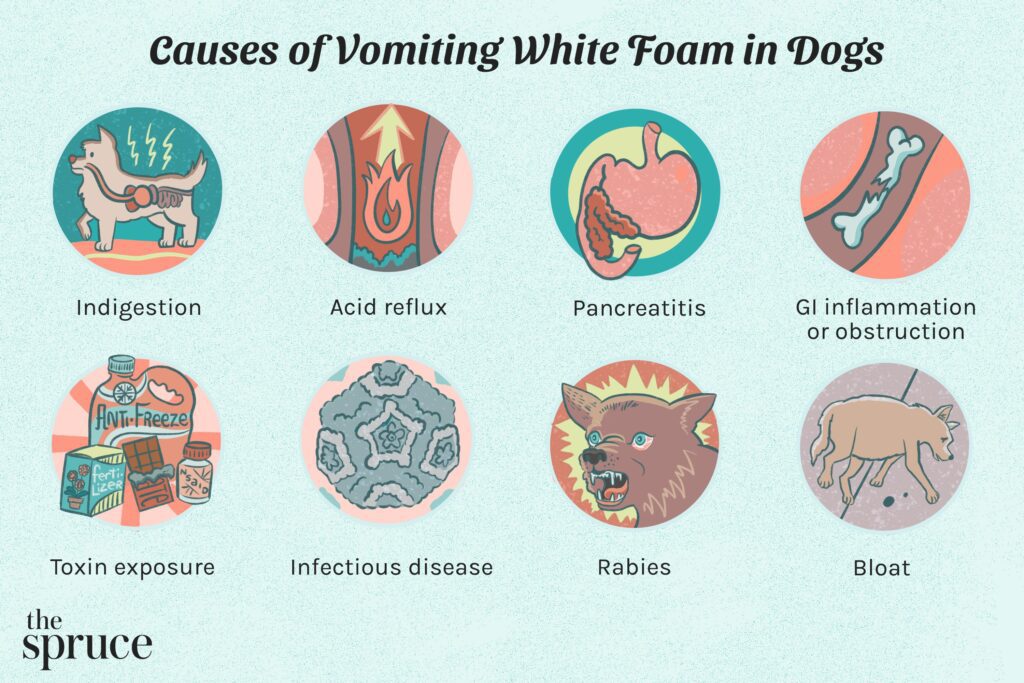Dog throwing up white foam can indicate gastrointestinal distress or ingestion of a foreign substance. Immediate veterinary attention is recommended.
Table of Contents
Dogs vomiting white foam might worry any pet owner. This symptom can stem from various causes, including mild gastrointestinal issues, ingestion of something indigestible, or more severe conditions like pancreatitis or kidney disease. Often, it may be linked to an empty stomach, where the dog vomits bile and stomach acids.
Stress or anxiety can also trigger this foamy vomit. Monitoring your dog’s behavior and noting any additional symptoms is crucial. Always consult a veterinarian to determine the exact cause and appropriate treatment. Early intervention can prevent potential complications and ensure your dog’s well-being.


Common Causes
Dogs throwing up white foam can be concerning for any pet owner. Understanding the common causes can help you address this issue promptly. Below are some of the frequent reasons your dog might be experiencing this problem.
Indigestion
Indigestion is a common cause of dogs throwing up white foam. It can occur if your dog eats too quickly or consumes something that doesn’t agree with their stomach. The foam is often a mix of saliva and gastric juices. To prevent indigestion, feed your dog smaller, more frequent meals and ensure they have a balanced diet.
Gastroenteritis
Gastroenteritis is an inflammation of the stomach and intestines. It is another reason for dogs vomiting white foam. Symptoms include vomiting, diarrhea, and abdominal pain. Causes of gastroenteritis can range from infections to dietary indiscretion. If you suspect gastroenteritis, consult your vet for a diagnosis and treatment plan.
Bloat
Bloat is a serious condition that can cause a dog to vomit white foam. It occurs when the stomach fills with gas, food, or fluid, causing it to expand. This condition can be life-threatening and requires immediate veterinary attention. Symptoms of bloat include a swollen abdomen, restlessness, and difficulty breathing.
Symptoms To Watch
Seeing your dog throw up white foam can be alarming. It’s important to know the symptoms that might accompany this. Recognizing these signs early can help you act quickly.
Lethargy
If your dog is throwing up white foam, also watch for lethargy. A lethargic dog will be less active and might seem tired. They may not respond to your calls or usual activities. This could indicate something serious. Monitor their energy levels closely.
Loss Of Appetite
Loss of appetite can be another warning sign. If your dog refuses to eat, it is not normal. They might avoid their favorite treats. This can lead to other issues like weight loss and weakness. Keep an eye on their eating habits.
Dehydration
Dehydration can happen quickly if your dog is vomiting. Check their gums; if they are dry, this is a sign. Also, if your dog is not drinking water, it is concerning. Dehydration can make your dog very sick.
| Symptom | Description |
|---|---|
| Lethargy | Low energy, tired, less active |
| Loss of Appetite | Refuses food, avoids treats |
| Dehydration | Dry gums, not drinking water |
When To Visit The Vet
Seeing your dog throwing up white foam can be distressing. Sometimes, it’s not serious. But there are times when a vet visit is crucial. Knowing the right time to seek professional help can save your dog’s life.
Emergency Signs
If your dog shows any emergency signs, visit the vet immediately. These include:
- Continuous vomiting for over 24 hours
- Blood in the vomit
- Severe lethargy
- Difficulty breathing
- Swollen abdomen
Chronic Vomiting
Chronic vomiting is a sign of a serious condition. If your dog vomits white foam often, it could indicate:
- Gastric issues
- Pancreatitis
- Liver disease
- Kidney problems
Track the frequency and duration of vomiting episodes. Share this information with your vet.
Severe Discomfort
Watch for signs of severe discomfort in your dog:
- Excessive panting
- Pacing or restlessness
- Whining or crying
- Refusing to eat or drink
If your dog exhibits any of these signs, contact your vet. Early intervention can prevent more serious issues.
Diagnostic Tests
When your dog is throwing up white foam, it’s crucial to identify the cause. Diagnostic tests help vets find the underlying issue. These tests include blood work, X-rays, and ultrasound. Let’s explore each test in detail.
Blood Work
Blood work is often the first step in diagnosing your dog. Vets check for signs of infection or inflammation. They also look for liver and kidney function. Blood tests can reveal anemia or dehydration. This information helps narrow down the possible causes.
X-rays
X-rays provide a visual of your dog’s internal organs. They help identify blockages in the digestive system. Vets can also spot tumors or growths. X-rays are useful for checking the size and shape of organs. This test offers a deeper look than blood work alone.
Ultrasound
An ultrasound gives detailed images of your dog’s abdomen. It helps vets see soft tissues more clearly. Ultrasounds can detect fluid build-up or abnormal tissue. This test is non-invasive and provides real-time results. Vets use it to get a clearer picture of internal issues.
Treatment Options
When your dog is throwing up white foam, it can be alarming. Knowing the right treatment options is essential to ensure your dog’s health. Here, we’ll explore effective methods to help your furry friend recover.
Medications
Veterinarians may prescribe medications to help your dog feel better. These can reduce nausea and control vomiting. Some common medications include:
- Anti-nausea drugs
- Antacids
- Probiotics
Always follow your vet’s instructions for dosage and duration.
Dietary Changes
Changing your dog’s diet can help soothe their stomach. Consider these changes:
- Small, frequent meals: Easier on the stomach.
- Bland diet: Boiled chicken and rice work well.
- Avoid fatty foods: They can worsen vomiting.
Monitor your dog’s reaction to new foods closely.
Fluid Therapy
Ensuring your dog stays hydrated is crucial. Fluid therapy can help. Methods include:
| Method | Description |
|---|---|
| Oral rehydration | Offer water or electrolyte solutions. |
| IV fluids | Administered by a vet for severe cases. |
Keep an eye on your dog’s hydration levels.

Home Remedies
When your dog is throwing up white foam, it can be concerning. Before rushing to the vet, you can try some home remedies. These remedies can help soothe your dog’s stomach. Here are some effective tips to try at home.
Bland Diet
A bland diet helps calm an upset stomach. Offer your dog plain boiled chicken. Remove the skin and bones. You can also give white rice. Both are easy to digest and gentle on the stomach. Serve small portions to avoid overloading the stomach.
Hydration Tips
Keeping your dog hydrated is crucial. Dehydration can worsen the situation. Offer ice chips if your dog refuses to drink water. You can also try giving them Pedialyte. It helps restore lost electrolytes. Ensure they have access to fresh water at all times.
Rest And Comfort
Rest is vital for recovery. Ensure your dog has a quiet place to rest. Avoid strenuous activities. Provide a soft bed for comfort. Patience is key. Your dog needs time to heal. Comfort them with gentle words and petting.
Preventive Measures
Preventing your dog from throwing up white foam is crucial. Ensuring their health and well-being involves taking several preventive measures. Below are some key strategies to help keep your furry friend healthy.
Proper Diet
A balanced diet is vital for your dog’s overall health. Feed your dog high-quality dog food that meets their nutritional needs. Avoid giving them table scraps or foods that can upset their stomach. Make sure they have access to fresh water at all times.
| Food Type | Benefits |
|---|---|
| High-Quality Dry Food | Provides essential nutrients |
| Fresh Vegetables | Rich in vitamins and fiber |
| Lean Meats | Good source of protein |
Regular Exercise
Exercise helps keep your dog in good physical shape. It also aids in proper digestion. Engage them in activities like walks, runs, or playtime. Aim for at least 30 minutes of exercise daily. This keeps their digestive system functioning well.
- Daily walks
- Play fetch
- Interactive toys
Routine Check-ups
Regular vet visits are essential for maintaining your dog’s health. Schedule check-ups at least once a year. Routine exams can help detect potential health issues early. Your vet may recommend vaccinations and parasite control measures.
- Annual health exams
- Vaccinations
- Parasite control
Following these preventive measures can help your dog stay healthy and reduce the chances of them throwing up white foam.
Special Considerations
Dog throwing up white foam can be alarming. Understanding the specific needs of different dogs is crucial. Each dog’s age and health condition can affect the cause and treatment.
Puppies
Puppies have sensitive stomachs. White foam vomit might signal an upset stomach. They may also vomit due to eating too fast or exploring harmful objects.
- Sensitive stomachs: Puppies can have delicate digestive systems.
- Eating too fast: Rapid eating can cause vomiting.
- Exploring harmful objects: Puppies may ingest harmful items.
Consult a vet if vomiting persists. Regular vet visits ensure puppy health.
Senior Dogs
Senior dogs can have different health issues. Vomiting white foam in older dogs may indicate serious problems.
- Chronic conditions: Senior dogs may have ongoing health issues.
- Weakened immune systems: Older dogs have less robust immune systems.
- Advanced age: Older dogs may have age-related illnesses.
Keep an eye on your senior dog. Seek veterinary help for persistent vomiting.
Dogs With Preexisting Conditions
Dogs with preexisting conditions need special care. Vomiting white foam can exacerbate existing health issues.
- Preexisting health issues: Dogs with conditions may react differently.
- Medication side effects: Some medications can cause vomiting.
- Dietary restrictions: Dogs with conditions may need special diets.
Discuss any vomiting with your vet. Ensure your dog’s treatment plan is up to date.


Frequently Asked Questions
What Does It Mean When A Dog Throws Up White Foam?
A dog throwing up white foam may indicate indigestion, acid reflux, or an empty stomach. Consult your vet if it persists.
Why Is My Dog Gagging And Coughing Up White Foam?
Your dog may be gagging and coughing up white foam due to kennel cough, bloat, or an upset stomach. Consult your vet.
When Should You Be Concerned About A Dog Throwing Up?
Be concerned if your dog vomits frequently, shows lethargy, has diarrhea, or refuses to eat. Seek veterinary advice.
What Does It Mean When You Throw Up White Foam?
Throwing up white foam can indicate stomach irritation, acid reflux, or an empty stomach. Seek medical advice if it persists.
Why Is My Dog Throwing Up White Foam?
White foam vomit in dogs can be due to indigestion, gastritis, or gastrointestinal issues.
Conclusion
White foam vomit in dogs can be alarming. Quick action and veterinary advice are crucial. Monitor your pet closely. Early detection of symptoms can prevent serious health issues. Always consult a vet for persistent problems. Your dog’s health should be a top priority.
Stay informed and proactive to ensure their well-being.


